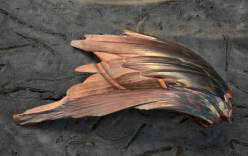
Chapter One: Melanin Images via Genetically-Modified Bacteria, a new exhibit showcasing the work of Lucy Kim, Broad’s sixth artist in residence, is on display in the Second Floor Connector Gallery and the Stanley Building Lobby (75 Ames Street), beginning October 24. The exhibit is open to all Broadies.
Since early 2019, Lucy Kim has been developing a process, in collaboration with Broad scientists, for creating images on paper with eumelanin. One of the main bio-pigments behind human skin, hair, and eye color. These differences in coloration are often used to justify ideas around race and color-based social hierarchies. Kim is exploring, materially and conceptually, what happens when images become visible through the same black and brown pigment that plays a key role in human coloration and appearance. Through an adaptation of the screen printing process, she transfers genetically-modified E. coli cells that produce melanin directly onto paper. The prints in this exhibition are the first finished works to come out of this process, marking the first chapter in ongoing research exploring the relationship between human vision, our biological and evolutionary frameworks, and social constructions.
The artist will be offering gallery tours to the public throughout the run of the exhibit, and an exclusive Broadie-only tour on Wednesday, January 18. Guests must register in advance.
About the Artist:
Lucy Kim is an interdisciplinary artist working across painting, sculpture and microbiology. In her hybrid works, she embraces distortion as a tool to deconstruct how we see what we see: the relationship between our evolved vision-centricity, constructed socio-cultural systems, and personal desires.
Kim is a recipient of the 2022 Creative Capital Award for her project printing images with bacteria that has been genetically-modified to produce melanin, the bio-pigment behind human skin, hair, and eye color. She began this project while an artist in residence at the Broad Institute of MIT and Harvard, and continues to develop it at Boston University, where she teaches. Through this project, Kim expands her committed study of distortion, which she first began in her sculptural paintings using unconventional processes in the studio.
Photo credit: Julia Featheringill
Images courtesy of the artist.









